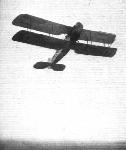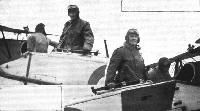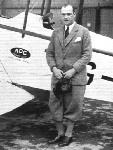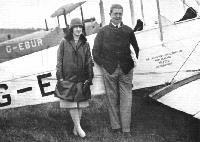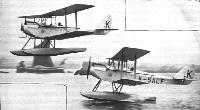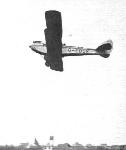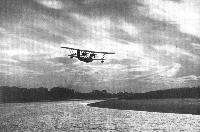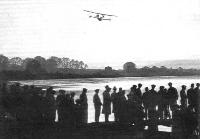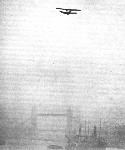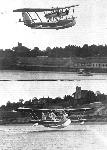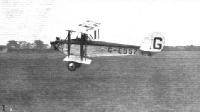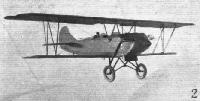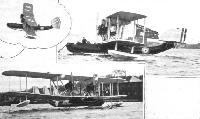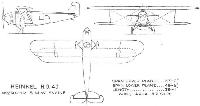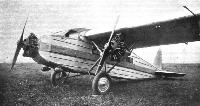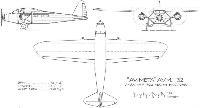Фотографии
-
IN THE LORD MAYOR'S SHOW: Aviation occupied quite a prominent place in'this year's procession. Our photographs show: (2) and (3) A D.H.9a day-bomber escorted by a contingent of No. 600 City of London Bombing Squadron, Auxiliary Air Force.
Самолёты на фотографии: De Havilland D.H.9A - Великобритания - 1918
-
"STALLED, BUT UNDER CONTROL": The Bristol Fighter, piloted by Squadron-Leader England, giving a demonstration of the new Handley Page automatic slots. In the photograph these can be seen in the open position. The rest of the wing is stalled.
Самолёты на фотографии: Bristol F.2A/F.2B Fighter - Великобритания - 1916
-
THE NEW HANDLEY PAGE AUTOMATIC WING TIP SLOTS: On the left, Mr. Handley Page is seen explaining the safety device to Sir Samuel Hoare and The Lady Maud Hoare. On the right, a view of the slot, and the angle indicator fitted on the experimental machine to show the angle at which the machine is descending in a horizontal attitude. The indicator is limited to an angle of 30 degrees, but the machine actually descends much steeper than that.
Самолёты на фотографии: Bristol F.2A/F.2B Fighter - Великобритания - 1916
-
OFFICIAL DEMONSTRATION OF THE AUTOMATIC SLOT: Last week, Sir Samuel Hoare, Secretary of State for Air (left), and Major H. E. Wimperis, Director of Scientific Research, made flights at Cricklewood in a Bristol Fighter fitted with the new Handley Page automatic slots. The pilot was Squadron-Leader T. England, who is seen above with his two distinguished passengers.
Самолёты на фотографии: Bristol F.2A/F.2B Fighter - Великобритания - 1916
-
IN THE LORD MAYOR'S SHOW: Aviation occupied quite a prominent place in'this year's procession. Our photographs show: (5) Passenger saloon of "Argosy" Air Liner.
Самолёты на фотографии: Armstrong Whitworth Argosy - Великобритания - 1926
-
Регистрационный номер: G-EBPU [2] The President of the Suffolk Club, the Hon. Lady Bailey, is here seen in an active position on her own "Moth," in which she took a large share in the joyriding work that was carried out continuously at the meeting at Hadleigh.
Самолёты на фотографии: De Havilland Moth / D.H.60 - Великобритания - 1925
-
Регистрационный номер: G-EBUF [2] "CIRRUS" SERVICE: Capt. T. N. Stack has now joined A.D.C. Aircraft, and has been equipped with a de Havilland "Moth" on which he visits the light 'plane clubs and private owners so as to ensure that quick and satisfactory service is given. Stack's machine is painted white and red, like that on which he flew to India, and carries the registration letters G-EBUF.
Самолёты на фотографии: De Havilland Moth / D.H.60 - Великобритания - 1925
-
At Hadleigh on Sunday: Here are Mr. and Mrs. Mill alongside the "Moth" in which they flew down and took part in the meeting at Hadleigh. Mr. Mill is the New Zealand distributor of "Moths" for the De Havilland Company, and the machine he is standing by will be taken by him to New Zealand.
Самолёты на фотографии: De Havilland Moth / D.H.60 - Великобритания - 1925
-
Регистрационный номер: K-SALF OFF TO "THE LAND OF A THOUSAND LAKES": A de Havilland "Moth" Seaplane, with "Cirrus II" engine and Short Duralumin floats, undergoing tests at Rochester, piloted by Capt. Broad. The machine has been sold to Finland.
Самолёты на фотографии: De Havilland Moth / D.H.60 - Великобритания - 1925
-
Регистрационный номер: G-EBQE SUFFOLK CLUB'S AIR DAY: (2) Capt. "Jerry" Shaw does his share of the joy-riding work in the Shell "Arom."
Самолёты на фотографии: De Havilland Moth / D.H.60 - Великобритания - 1925
-
Регистрационный номер: G-EBUF [2] AT HADLEIGH: On the left is the A.D.C. "Cirrus" Service "Moth" which was flown down by Capt. Stack with Mrs. Stack as passenger. On the right Capt. Stack is on the same machine giving his interesting exhibition of stunting.
Самолёты на фотографии: De Havilland Moth / D.H.60 - Великобритания - 1925
-
Регистрационный номер: G-EBOY, G-EBPU [2] SUFFOLK CLUB'S AIR DAY: (3) Squad.-Ldr Noakes giving his usual clever exhibition of crazy flying on a "Moth."
Самолёты на фотографии: De Havilland Moth / D.H.60 - Великобритания - 1925
-
Регистрационный номер: G-EBRO THE WESTLAND "WIDGEON": Squad.-Ldr. The Hon. R. A. Cochrane and Flight-Lieut. Drew made their interesting anв successful European air tour on the Westland "Widgeon" (Cirrus II engine). The monoplane proved very stable in bumpy weather and a pleasure to fly. Neither the machine nor engine gave the least trouble during the long trip, thereby fully living up to their deserved reputations.
Самолёты на фотографии: Westland Widgeon - Великобритания - 1924
-
Регистрационный номер: G-EBRL SUFFOLK CLUB'S AIR DAY: (4) The two Westland "Widgeons" which put in some excellent work at joy-riding.
Самолёты на фотографии: Westland Widgeon - Великобритания - 1924
-
A NEW AMERICAN AMPHIBIAN: The Loening OL.8, fitted with a 425 h.p. Pratt and Whitney "Wasp" air-cooled radial engine, which recently completed successful trials for the U.S. Navy Bureau of Aeronautics.
Самолёты на фотографии: Loening OL / OA - США - 1923
-
A CLIPPER OF THE CLOUDS: The Short "Singapore," with two Rolls-Royce "Condor" engines, on which Sir Alan Cobham is starting to-day on his 20,000 miles' flight around Africa, photographed during a test flight over the Medway.
Самолёты на фотографии: Short Singapore I / S.5 - Великобритания - 1926
-
"GOOD BYE AND GOOD LUCK": The Short "Singapore," two Rolls-Royce "Condor" engines, starting on its 20,000-miles flight from Rochester, on November 17.
Самолёты на фотографии: Short Singapore I / S.5 - Великобритания - 1926
-
THROUGH FOG TO SUNSHINE: The Short "Singapore" flying over London on its way to the coast.
Самолёты на фотографии: Short Singapore I / S.5 - Великобритания - 1926
-
Регистрационный номер: G-EBUP [2] TESTING THE SHORT "SINGAPORE": These two views show the machine undergoing tests for Sir Alan Cobham, piloted by Mr. Lankester Parker, at Rochester, where the works of Short Brothers are situated. The Wakefield Survey Flight around Africa is scheduled to start on or about November 15.
Самолёты на фотографии: Short Singapore I / S.5 - Великобритания - 1926
-
Регистрационный номер: G-EBUP [2] THE FLIGHT AROUND AFRICA: Three views of the Short "Singapore" all-metal flying-boat, fitted with two Rolls-Royce "Condor" engines, which will be used by Sir Alan Cobham on his forthcoming 20,000 miles' flight.
Самолёты на фотографии: Short Singapore I / S.5 - Великобритания - 1926
-
A NEW DE HAVILLAND FOR AUSTRALIA: Side elevation of the D.H.61, with Bristol "Jupiter" engine. Note the placing of the pilot's cockpit in a raised position aft of the cabin so as to improve the view.
Самолёты на фотографии: De Havilland Giant Moth / D.H.61 - Великобритания - 1927
-
Регистрационный номер: G-EBSZ SUFFOLK CLUB'S AIR DAY: (1) The Club's own Blackburn "Bluebird" is seen taking off.
Самолёты на фотографии: Blackburn Bluebird / L.1 - Великобритания - 1924
-
A "BLUEBIRD" ON TOUR: During the past week Mr. Charles H. Blackburn and Lieut. A. M. Blake have been making a demonstration tour of Southern England on one of the new Blackburn "Bluebird II" machines with Armstrong-Siddeley "Genet" engine. Side-by-side seating is a feature of this machine. Note the door in the side of the fuselage.
Самолёты на фотографии: Blackburn Bluebird / L.1 - Великобритания - 1924
-
HARVARD UNIVERSITY FLYING CLUB: (No. 2) The first machine that the members used and owned. It is a Travel-Air biplane.
Самолёты на фотографии: Travel Air 1000 / 2000 / 4000 - США - 1925
-
HARVARD UNIVERSITY FLYING CLUB: (No. 3) The new Travel-Air biplane fitted with a Curtiss O XX6 (100 h.p.) engine, now used, which was obtained this summer by the members when an opportunity arose of disposing of the old machine advantageously.
Самолёты на фотографии: Travel Air 1000 / 2000 / 4000 - США - 1925
-
"SOUTHAMPTONS" FOR AUSTRALIA: These photographs show the first of the Supermarine "Southamptons" built for the Royal Australian Air Force. Two of these machines, fitted with Napier "Lion" engines will be sent out by steamer, and will join up with the Far East Flight now proceeding. The Australian machines are similar to those of the Far East Flight, except for the fact that they have wood hulls
Самолёты на фотографии: Supermarine Southampton / Solent - Великобритания - 1925
-
The Heinkel H.D.40 Commercial Aeroplane taking off for a test flight. The machine has been designed mainly as a newspaper carrier.
Самолёты на фотографии: Heinkel HD.27/39/40/44 - Германия - 1926
-
The Heinkel H.D.40 Commercial Aeroplane: Front View
Самолёты на фотографии: Heinkel HD.27/39/40/44 - Германия - 1926
-
The Heinkel H.D.40 Commercial Aeroplane: Three-quarter rear view. The engine is a B.M.W. VI of 465-600 h.p.
Самолёты на фотографии: Heinkel HD.27/39/40/44 - Германия - 1926
-
Heinkel H.D.40 465/600 h.p. B.M.W. Engine
Самолёты на фотографии: Heinkel HD.27/39/40/44 - Германия - 1926
-
AN ITALIAN LIGHT 'PLANE: Two views of the Giovanni "Agusta" parasol monoplane, fitted with a 15-h.p. Anzani engine. It has a span of 46 ft. and a length of 23 ft. The wing area is 226 sq. ft., the weight empty is 441 lbs., and the weight laden is 661 5 lbs. It is said to have a speed range of 22-62 m.p.h.
Самолёты на фотографии: Agusta Ag2 - Италия - 1927
-
THE "AVIMETA" A.V.M.132: View of Fuselage, engines, undercarriage, etc.
Самолёты на фотографии: Avimeta 132 - Франция - 1927
-
THE "AVIMETA" A.V.M.132: Front View. The engines are Salmsons, of 230 h.p. each.
Самолёты на фотографии: Avimeta 132 - Франция - 1927
-
THE "AVIMETA" A.V.M.132: Side View.
Самолёты на фотографии: Avimeta 132 - Франция - 1927
-
"Avimeta" A.V.M.132 3-230 hp Salmson Engines
Самолёты на фотографии: Avimeta 132 - Франция - 1927
Статьи
- Flight

